Regardless of your company size or industry, we all have the same goal: hit our revenue goals.
While we all have this in common, the process of setting the goals looks pretty different in enterprises vs. start-ups.
3 Keys to Start-Up Marketing Revenue Forecasting
Early-stage companies face the challenge of setting their KPIs with limited benchmark data to base them on. For example, start-ups don’t typically have enough historical data to understand the percentage of leads that convert to MQLs, percentage of MQLs that convert to SQLs and so forth.
Forecasting target numbers in your demand generation strategy takes a bit of iteration in order to achieve the practicality and stability you’re looking for. While this isn’t always easy, it’s definitely always possible!
Lauren O’Brien, VP of Marketing at Balto, walks us through her process for setting practical, attainable KPIs.
Her advice includes:
-
Start with a revenue target and work backward from there
-
Make the creation of your KPIs a collaborative process with Sales to achieve alignment on goals
-
Establish and communicate clear paths for achieving the goals to Sales and Marketing teams
Tune in now to learn how to build a foundational, iterative process for establishing KPIs for your start-up.
Video Transcript:
CAROLINE: Hi, today I am here with Lauren O'Brien. Lauren is a super sharp B2B SaaS marketer with experience in growth marketing and startup marketing from early stage to merger and acquisition. And today she is the vice president of marketing at Balto. Lauren, thank you so much for being with me today.
LAUREN: Yeah, of course, happy to be here.
CAROLINE: So one of the challenges for marketers in early-stage startups is that they have usually no benchmark data, which makes building a KPI model that ensures that you get your revenue quite challenging. So my question for you today is, what's your advice for marketers that are trying to be on their KPI and make sure they hit the revenue goal when they are in early stage startups?
LAUREN: Yeah, sure. So I would say, you know, for me the first step and something that I think, unfortunately, a lot of marketers get wrong, is you should really be starting with a revenue target and working backwards from there. If you're starting and thinking about, okay, how many leads do we need to generate this quarter? And that's the main KPI you're focusing on probably not starting at the right place.
So what I always focus on is first, okay, what's the revenue target we're trying to hit this year. How does that break down quarterly? And then typically you can do some easy math, even if you don't have a great benchmarks to go off of, to think about what you need to be bringing into the business from a pipeline perspective to enable the company to hit that revenue number. So for me, that typically means, you know, do you have data on what your close rates are or have a sense of what your sales cycle looks like?
If you know that you close about a quarter of the deals that you generate as a business, then you know that for a marketing team, you need to bring in four times that amount in pipeline so that your sales team has the ability to close the right amount to hit their revenue number. And so you then can work further back from there to say, okay, if this is how much pipeline, and this is roughly the average deal size that we bring in as a company, how many opportunities do we need to see that we're generating this quarter and then ultimately you'll need to work back to, okay, yes, there's a certain number of leads you need to be putting through the pipeline in order to be able to have things convert at a certain rate where you are going to hit that up pipeline and revenue number. But I think starting from that reverse demand gen waterfall perspective and with revenue as the focus is really the most important step when defining KPIs.
CAROLINE: All right, right, right. And so something else that you're doing that I think is really interesting is, so you build your assumptions and this is all great. How do you communicate this model to your team, to the sales team, to, you know, your leadership, etcetera.
LAUREN: Yeah, yeah, so I think that's something that you have to be doing as a collaborative process. You can't just go and sit off in a room somewhere and just decide, okay, this is how we're going to hit the revenue number. And this is based on all these assumptions we've made or data we have in marketing.
And this is great because the reality is every step of that funnel requires the right alignment between sales and marketing. You're both owning each of these steps and looking at how things are closing throughout the pipeline. So, the process I typically take is really partnering with sales leadership, anything coming up with that model to begin with, when you're both looking at it and thinking about, hey, what do we think our close rate is going to be? What is it today? What do we want it to be moving forward? What are the levers that we need to pull on in order to get there?
And then really once you're doing that collaborative process and the aligning on what you're agreeing to, it means you have a clear path to how you're gonna get to those goals. And it's a much more, you know, aligned opportunity going into the quarter. There's less finger pointing of like, well, we brought the leads in, but they didn't convert, and that's sales's problem. That's not really the conversation, right? It's not sales's problem if leads aren't converting. So that's a really important part of the process. So you're all owning the numbers. And I sit down with my team and I walk them through that full model too. So everybody understands where our targets are coming from.
And I think it gets everybody more excited and motivated to see the rationale behind the targets. And nobody wants to feel like they're getting into a quarter or a year, and the number they're looking to hit is something people picked out of thin air, right? And they just decided, okay, we wanted, we want this many opportunities this quarter. So it really helps everybody understand the context.
CAROLINE: Right, right, right. And I think something else you talked about last time, we talked is how iterative this process needs to be, right. Especially when you make assumptions, making sure that you check-in, not every three months, but like every week, right.
LAUREN: Yeah.
CAROLINE: With sales and make sure that you realign expectations, goals if need be, and that you take the right measures, right, to adjust to new assumptions.
LAUREN: Yeah, absolutely. I mean, I would say that, you know, there's more, that changes throughout the quarter and you don't wanna wait until the end of it to figure that out. And so something that we look at for instance is, you know, we have several different sources of ops and pipeline. It might be marketing partnerships, you might have a sales outbound motion. You might have your own sales team of account executives that are sourcing some ops and pipeline. Each of those is likely going to convert at a different rate through the pipeline, right?
You're gonna see an outbound sourced deal that was a cold call, likely take longer to convert than somebody that comes to your website and says, I would like a demo, I'm interested in learning more about your solution.
CAROLINE: Right.
LAUREN: And so it's really important to be looking at this data and optimizing and revisiting and tweaking your assumptions and what you need to see, because if you're in a quarter and 50% of your pipeline is generated by outbound, that's great, but it might not close at the rate you need it to hit the revenue target that quarter. So you shouldn't necessarily be ringing the victory bell that like, wow, we did it, we hit the pipe target we wanted to hit.
And now we're definitely going to hit a revenue target because that might just not convert at the same rate as these other sources.So we typically have weekly meetings where all the sales and marketing leaders are taking a look at this data together to see how we're tracking. If conversion rates are off from what we expected, why that might be and what changes we need to make in the process.
CAROLINE: Awesome. Well, Lauren, thank you so much for sharing your insights with us today I really appreciate it.
LAUREN: Yeah, of course. Thank you so much, take care.





